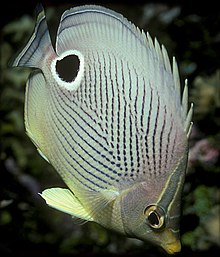Automimicry

In zoology, automimicry, Browerian mimicry, or intraspecific mimicry, is a form of mimicry in which the same species of animal is imitated. There are two different forms.
In one form, first described by Lincoln Brower in 1967, weakly-defended members of a species with warning coloration are parasitic on more strongly-defended members of their species, mimicking them to provide the negative reinforcement learning required for warning signals to function. The mechanism, analogous to Batesian mimicry, is found in insects such as the monarch butterfly.
In another form, first noted by
Automimicry has sometimes been put to military use. The A-10 Thunderbolt (Warthog) was often painted with a false canopy on its underside, imitating itself, while the armoured recovery vehicle variant of the Churchill tank had a dummy gun, imitating an armed variant of the same tank.
Mimicry of distasteful members of the same species
Automimicry was first reported by the ecologist
It turns out that many species of insects are toxic or distasteful when they have fed on plants that contain chemicals of particular classes, but not when they have fed on plants that lack those chemicals. For instance, some
The existence of automimicry in the form of non-toxic mimics of toxic members of the same species (analogous to
False head
Many insects have filamentous "tails" at the ends of their wings and patterns of markings on the wings themselves. These combine to create a "false head". This misdirects predators such as birds and jumping spiders (
Each hind wing in these [hairstreak] butterflies is furnished with a 'tail', which in certain species is long, thin, and apparently knobbed at the end. When the butterfly is resting on a flower the wings are closed and the hind wings are kept in constant motion ... This movement, together with their appearance, causes the 'tails' to bear the strongest likeness to the antennae of a butterfly; the real antennae being held [downwards] so as not to attract attention. Close to the base of the supposed antennae an eye-like mark, in the most appropriate position, exists in many species. The effect of the marking and movement is to produce the deceptive appearance of a head at the wrong end of the body. The body is short and does not extend as far as the supposed head, so that the insect is uninjured when it is seized.[15]
A 1981 experiment confirmed the expected correlation between deceptiveness and survival in butterflies.[12]
Among vertebrates, snakes such as the rubber boa and the coral snake coil up and hide their head, instead displaying their tail as a false head.[16] Some fishes such as the foureye butterflyfish have eyespots near their tails, and when mildly alarmed swim slowly backwards, presenting the tail as a head; however, various hypotheses for the function of such eyespots have been proposed.[17] Several species of pygmy owl bear false eyes (ocelli) on the back of the head, misleading predators into reacting as though they were the subject of an aggressive stare.[18]
Military usage
Automimicry has sometimes been used in military vehicles and aircraft. Among vehicles, specialised variants such as the British Second World War Churchill armoured recovery vehicle had no room for an actual gun, but was fitted with a dummy weapon, imitating the armed version of the same tank, to give it some protection.[19]
The ground attack A-10 Thunderbolt (Warthog) was sometimes painted with a camouflage scheme that included both disruptive coloration and automimicry in the form of a false canopy on the underside. This was intended to confuse the enemy about the aircraft's attitude and likely direction of travel.[20][21]
-
Armoured recovery vehicle variant of Churchill tank, with dummy gun, imitating an armed variant of the same tank
-
Underside ofA-10 Thunderbolt II with false canopypainted in, as if the plane was the right way up, imitating itself
Notes
References
- PMID 28556119.
- ^ ISBN 9780198528593.
- S2CID 45185502.
- PMID 17567561.
- PMID 16591844.
- S2CID 9920426.
- S2CID 84450857.
- PMID 16543181.
- PMID 16591844.
- .
- S2CID 84454608.
- ^ S2CID 34146954.
- PMID 28652941.
- .
- ^ Poulton, Edward B. (1890). The Colours of Animals. Kegan Paul, Trench, Trübner. pp. 206–209.
- ISBN 978-1-4214-2360-9.
- JSTOR 1446319.
- ^ "Northern Pygmy Owl (Glaucidium californicum)". Owl Research Institute. Archived from the original on 28 December 2015. Retrieved 23 August 2015.
- ^ Chamberlain, Peter; Ellis, Chris (1969). British and American Tanks of World War II. Arco Publishing. p. 70.
- ISBN 0-87021-059-9.
- ISBN 0-89747-400-7.



